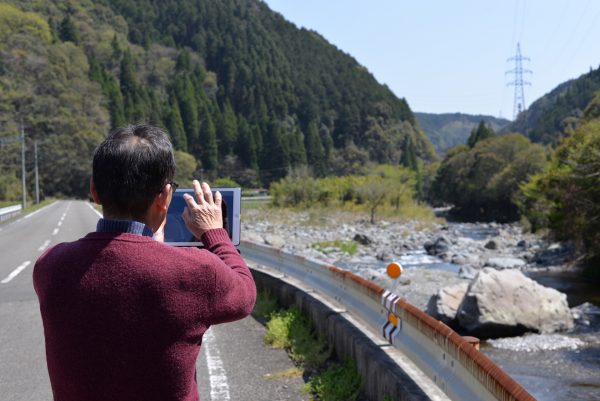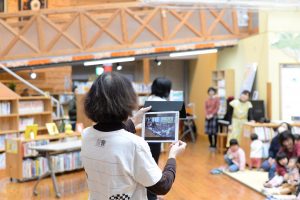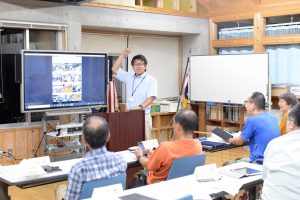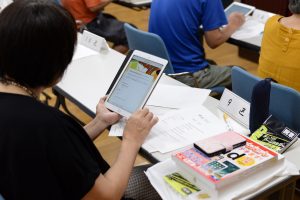
May 23, 2019
山江村 情報化推進員 の取組みが「 平成30年版 情報通信白書 」に掲載Yamae Village ICT promoters’ efforts are published in the 2018 White Paper on Information and Communications in Japan
熊本県山江村と須藤研究室が取り組んでいる共同研究のなかで、地域と役場をつなぐ新たな役割として注目を浴びているのが2017年からスタートした山江村情報化推進員の取組みです。
村内16地区に1名ずつ推進員がおり、各地区の出来事や地域課題を画像や動画で撮影し、コメントや他の住民への周知方法、改善に向けたアイディア等を添えて専用画面に入力します。推進員が自ら気づいたことだけではなく、区長や住民から寄せられた地区全体に関わる問題点や困り事を代理入力することもあります。
推進員からの情報は、山江村地域づくり研究所が整理し、企画調整課長を通じて他課や外部機関へ連絡し、その回答を各区の推進員に対してフィードバックをします。必要に応じて議会で補正予算化し、対応することもあります。村内へは、広報紙や山江村ケーブルテレビで周知する他、地区や住民での解決が必要な内容は、各区の住民で話し合いの場を設けることもあります。
投稿内容は、地区の情報であれば基本的に何でも良く、例えば、「親子のシカが住宅地に出現」「雨による土砂災害」「双方向共にカーブミラーなどの設置が必要」をはじめ、地区の伝統行事や日々の生活等、現在まで100件を超える情報が寄せられています。特に鳥獣被害等は、これまで役場に電話で連絡があっても状況をよく説明できず、コミュニケーションに時間がかかっていましたが、推進員に貸与しているタブレット端末では写真や位置情報を取得して共有できるため、状況の把握がしやすいというメリットがあります。
各地区の推進員は、年齢も生活スタイルも異なるなかで、それぞれが出来る範囲で活動をしています。入力操作に不安がある推進員に対しては、地域づくり研究所の職員が随時サポートをしています。年に2回推進員の全体会議を開催し、他の推進員の入力内容を共有し、事業改善に向けて課題整理や意見交換を行っています。
・掲載先
1) 総務省,平成30年版情報通信白書, p171~172
2) 総務省,情報通信白書平成30年版概要「2018年版情報通信白書について」, p11
3) Ministry of Internal Affairs and Communications, Japan,Outline of the 2018 White Paper on Information and Communications in Japan, p11
※本共同研究が、東京法令出版「ビジュアル公民 熊本県版2019」p3に掲載されました(5/27追記)
記事:並木志乃(特任講師)
As part of a collaborative research project between Yamae Village in Kumamoto Prefecture and Sudoh laboratory, the efforts of Yamae Village ICT promoters since 2017 have attracted attention in their new role of connecting the local community and Yamae Village office.
There is one ICT promoter in charge of each of the 16 districts in the village, and they post photographs or videos about the events and regional issues of each district on a dedicated system, adding comments, ways to inform other residents, and ideas for improvement. In addition to collecting information on matters they themselves have noticed, the promoters also input information received from residents and local officials about problems or issues concerning the whole district.
Information from the promotion supporters is organized and edited by the Yamae Village Regional Development Research Institute and communicated to other departments and external organizations through the Planning and Coordination Division manager. Responses from the other departments and external organizations are then fed back to the promotion staff in each district. If necessary, Yamae Village office submits a supplementary budget to the local council to solve the problem. In addition, besides sharing information by public relations newsletter and Yamae Village Cable television, residents’ meetings may be set up to discuss matters that need to be resolved among the residents of each district themselves.
The contents of the post can be basically anything as long as it is information about the district, such as “parent and child deer appear in residential areas”, “earth and sand disaster due to rain”, “traffic mirrors required for both directions”. More than 100 pieces of information have so far been posted, including traditional events and episodes from daily life . In particular, the situation of damage by harmful animals could not be easily explained by telephone and took a long time to communicate to the village office, whereas ICT promoters can take photos and location information using their loaned tablets, thus having the advantage of making it easier to understand the situation than before.
With their differences in age and lifestyle, the ICT promoters engage in activities to the extent they can. The staff of the Yamae Village Community Research Institute can provide support at any time to promoters who are unsure about the data input process. A general meeting of ICT promoters is held twice a year, at which input contents are shared with other promotion supporters, and issues are discussed and ideas are exchanged for business improvement.
– Published pages
1) Ministry of Internal Affairs and Communication, Japan, 2018 White Paper on Information and Communications, p171~172 (Japanese)
2) Ministry of Internal Affairs and Communication, Japan, Outline of the 2018 White Paper on Information and Communications in Japan, p11 (Japanese)
3) Ministry of Internal Affairs and Communications, Japan, Outline of the 2018 White Paper on Information and Communications in Japan, p11
※ This collaborative research has been also published in “Visual Komin(Civics) Kumamoto Version 2019 (a textbook for junior high school)”, Tokyo Horei Publishing CO.,LTD (posted May 27)
Text: Shino Namiki (Project Lecturer)
Proofreading: David Buist (Project Senior Specialist)
主担当教員Associated Faculty Members
教授
非公開: 須藤 修
Professor






